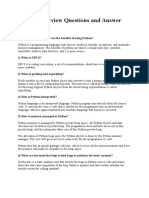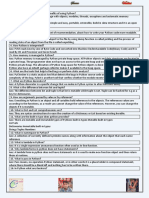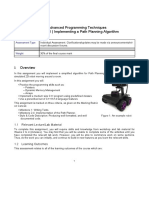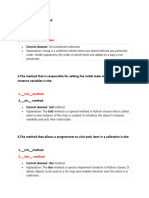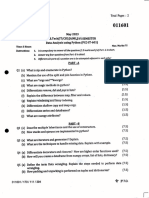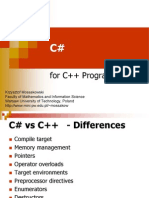Python_Interview_Questions_with_Answers
Uploaded by
atalparkecPython_Interview_Questions_with_Answers
Uploaded by
atalparkec100 Python Interview Questions with Answers
1. What are Python's key features?
Answer: Python is an interpreted, dynamically-typed, and high-level programming language. It supports
object-oriented programming, has built-in data structures, automatic memory management, and is easy to
read and write.
2. What is the difference between deep copy and shallow copy?
Answer: A shallow copy creates a new object but inserts references to the original objects. A deep copy
creates a completely independent copy of the original object, including all nested objects.
3. Explain Python's memory management.
Answer: Python uses automatic memory management with garbage collection. It keeps track of object
references and removes unused objects to free memory.
4. What is PEP 8, and why is it important?
Answer: PEP 8 is Python's style guide that provides best practices for writing clean and readable code.
Following PEP 8 improves code consistency and maintainability.
5. What are Python's built-in data types?
Answer: Python has several built-in data types including int, float, str, list, tuple, set, dict, and bool.
6. Explain the difference between lists and tuples.
Answer: Lists are mutable (can be changed), while tuples are immutable (cannot be changed). Tuples are
faster than lists due to their immutability.
7. What is the difference between Python 2 and Python 3?
Answer: Python 3 introduced several improvements over Python 2, including better Unicode support, new
syntax (e.g., print() as a function), and improved integer division (// operator).
8. How does Python handle memory allocation?
Answer: Python manages memory using private heap space, which contains all Python objects and data
structures. The memory is handled by Python's built-in garbage collector.
9. What is the difference between mutable and immutable types?
Answer: Mutable types (e.g., lists, dictionaries) can be changed after creation, whereas immutable types
(e.g., strings, tuples) cannot be modified after they are created.
10. Explain the use of *args and **kwargs in Python.
Answer: *args allows a function to accept a variable number of positional arguments, while **kwargs allows a
function to accept a variable number of keyword arguments.
11. What is the difference between a shallow copy and a deep copy?
Answer: A shallow copy only copies references to objects, whereas a deep copy creates new objects
recursively, ensuring no references are shared.
12. How does Python's garbage collector work?
Answer: Python uses automatic garbage collection, primarily using reference counting and a cyclic garbage
collector to remove objects that are no longer needed.
13. What are Python's built-in functions?
Answer: Some built-in functions in Python include len(), type(), id(), sorted(), sum(), min(), max(), and abs().
14. How do you handle exceptions in Python?
Answer: Exceptions are handled using try-except blocks. Optionally, you can use finally to execute cleanup
code and else to run code if no exception occurs.
15. What is the difference between a module and a package?
Answer: A module is a single Python file, while a package is a collection of modules organized in a directory
with an __init__.py file.
16. How does Python implement multi-threading?
Answer: Python provides threading using the threading module, but due to the Global Interpreter Lock (GIL),
true parallel execution is better achieved with multiprocessing.
17. What is a lambda function in Python?
Answer: A lambda function is an anonymous function defined using the lambda keyword. Example: lambda x:
x * 2.
18. What are list comprehensions?
Answer: List comprehensions provide a concise way to create lists. Example: [x for x in range(10) if x % 2 ==
0].
19. Explain the difference between is and == in Python.
Answer: is checks for object identity (whether two variables reference the same object), while == checks for
equality (whether the values are the same).
20. How do you open and read a file in Python?
Answer: Using the open() function with 'r' mode: with open('file.txt', 'r') as file: data = file.read().
You might also like
- 300 Python Interview Questions and Solutions100% (1)300 Python Interview Questions and Solutions88 pages
- Top 25 Python Programming Viva QuestionsNo ratings yetTop 25 Python Programming Viva Questions4 pages
- Beginner – Technical Questions & AnswersNo ratings yetBeginner – Technical Questions & Answers8 pages
- Python Interview Questions Answers Free PDFNo ratings yetPython Interview Questions Answers Free PDF16 pages
- Python Questions for Cloudy Coders DriveNo ratings yetPython Questions for Cloudy Coders Drive28 pages
- 80 Python Interview Questions & AnswersNo ratings yet80 Python Interview Questions & Answers23 pages
- 1) What Is Python? What Are The Benefits of Using Python?No ratings yet1) What Is Python? What Are The Benefits of Using Python?28 pages
- Python Interview Questions For Freshers - Docx 1No ratings yetPython Interview Questions For Freshers - Docx 16 pages
- python programming question bank unit wise by Rupesh ✓No ratings yetpython programming question bank unit wise by Rupesh ✓24 pages
- Python Interview Questions and Answers for FreshersNo ratings yetPython Interview Questions and Answers for Freshers7 pages
- Python Interview Questions and Answers PDFNo ratings yetPython Interview Questions and Answers PDF4 pages
- Mastering Python Programming: A Comprehensive Guide: The IT CollectionFrom EverandMastering Python Programming: A Comprehensive Guide: The IT Collection5/5 (1)
- PHP5 Tutorial - Magic Methods - Clone Method: Cloning MeanNo ratings yetPHP5 Tutorial - Magic Methods - Clone Method: Cloning Mean5 pages
- Instant Download (Ebook) Design Patterns in C#: A Hands-on Guide with Real-world Examples by Vaskaran Sarcar ISBN 9781484260616, 9781484260623, 1484260619, 1484260627 PDF All Chapters100% (9)Instant Download (Ebook) Design Patterns in C#: A Hands-on Guide with Real-world Examples by Vaskaran Sarcar ISBN 9781484260616, 9781484260623, 1484260619, 1484260627 PDF All Chapters55 pages
- Parker J. Python Arrays and Python Data Types For Beginners 2024No ratings yetParker J. Python Arrays and Python Data Types For Beginners 2024336 pages
- Advanced Programming Techniques Assignment 1 - Implementing A Path Planning AlgorithmNo ratings yetAdvanced Programming Techniques Assignment 1 - Implementing A Path Planning Algorithm10 pages
- Data Science With Python Lesson 05 Mathematical Computing With Python NumPyNo ratings yetData Science With Python Lesson 05 Mathematical Computing With Python NumPy59 pages
- Java How to Program Early Objects 11th Edition Deitel Test Bank - Available For Instant Download And Reading100% (2)Java How to Program Early Objects 11th Edition Deitel Test Bank - Available For Instant Download And Reading45 pages
- Top 100 Python Interview Questions & Answers For 2021 - EdurekaNo ratings yetTop 100 Python Interview Questions & Answers For 2021 - Edureka24 pages
- 9.15 - Shallow vs. Deep Copying: #Include #IncludeNo ratings yet9.15 - Shallow vs. Deep Copying: #Include #Include7 pages
- Commonly Asked Python Telephonic Interview Questions100% (1)Commonly Asked Python Telephonic Interview Questions6 pages
- 50 technical C++ Interview Questions with AnswersNo ratings yet50 technical C++ Interview Questions with Answers13 pages
- Java All in One For Dummies Fifth Edition Doug Lowe pdf download100% (2)Java All in One For Dummies Fifth Edition Doug Lowe pdf download79 pages
- Instructions: Answer Any Four Que"stions From Part - 8 in Detalf. Different Sub-Parts of A Question Are To Be Attempted AdjacentNo ratings yetInstructions: Answer Any Four Que"stions From Part - 8 in Detalf. Different Sub-Parts of A Question Are To Be Attempted Adjacent2 pages
- AD3251 - DS - Unit 1- ABSTRACT DATA TYPESNo ratings yetAD3251 - DS - Unit 1- ABSTRACT DATA TYPES62 pages




























